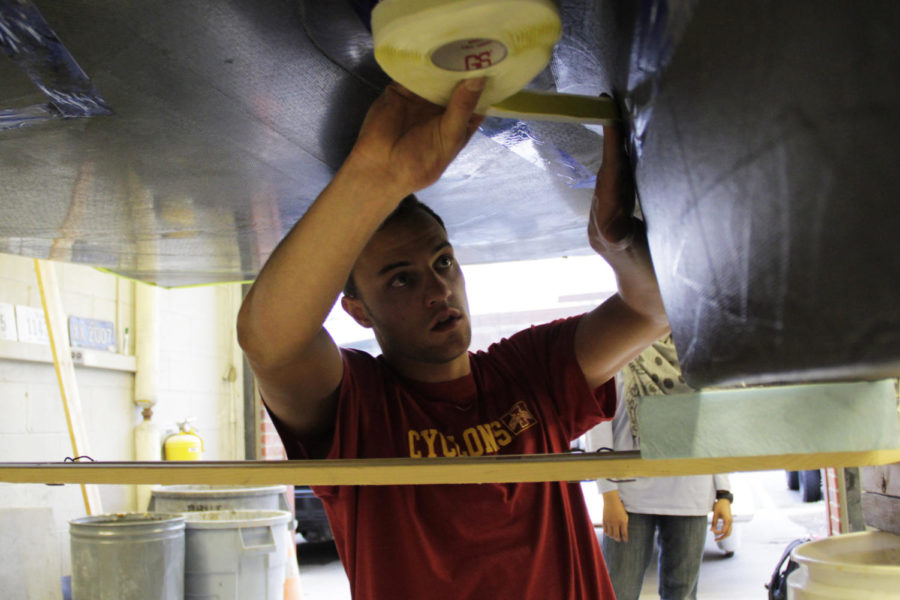Racing with the sun: Team PrISUm readies for summer races, preps solar-powered Phaeton
April 25, 2014
Team PrISUm hopes to get first place in this year’s American Solar Challenge, an eight-day race in a course that is more than 1,700 miles — from Austin, Texas, to the Twin Cities in Minnesota.
This summer, the Formula Sun Grand Prix will serve as a qualifying race for the cross country American Solar Challenge race that will take place later in the summer.
The Grand Prix takes place every year, whereas the American Solar Challenge falls on the even numbered years.
In 2012, PrISUm’s car, Hyperion, placed second in both the Grand Prix as well as the Solar Challenge.
The team didn’t do as well as it hoped in the 2013 Formula Sun Grand Prix. Due to a problem with a wheel, it placed third, only two laps behind the team that finished in first place.
“We’re the only team that has successfully built and qualified a new car for every American Solar Challenge that has been held,” said Todd Wegter, electrical director for Team PrISUm and senior in computer engineering.
Wegter also said that each car has a two-year build cycle and then a two-year race cycle.
Adam Hansen, mechanical director and junior in industrial technology, said that the first year is dedicated to the designing and test work, whereas all the building and assembling is done in the second year.
This year’s car is called Phaeton, named after the Greek sun god’s son. Hansen said that it is a smaller, modified version of Hyperion.
Since Hyperion was such a success, Wegter said that there hasn’t been too many changes to the electrical system of Phaeton.
One problem with Hyperion was that the frame was too large and the body was too heavy. Hansen said that they changed the body from a fiber-glass body to a carbon fiber body on Phaeton, which shaved off more than 100 pounds.
On a typical Grand Prix race day, the team would get one hour in the morning to charge the car from the solar rays. The race typically goes from 9 a.m. to 5 p.m.
During the Grand Prix race, teams try to make as many laps as possible during a three-day, eight-hour race. At the end of the day, they also get another hour of charge time as the car is powered by solar energy.
During the American Solar Challenge, the solar car has a lead vehicle in front and a chase vehicle behind. Hansen said that because the solar car is only an experimental vehicle, it must have a chase vehicle that will do whatever the solar car does.
An equipment vehicle tends to be behind the chase car.
“People on the road with us try and take pictures. It isn’t blocked off at all,” Hansen said.
The solar car averages about 45 miles per hour, and Wegter said it can reach up to 70 miles per hour, though it would use up extra energy.
“Driving down the highway going 55 in this piece of aluminum and fiber glass that you and some ragtag college kids built, that’s something else,” Wegter said.
Drivers are chosen based on weight, seniority and the time and effort they spent on the car. They also have to be good drivers.
The solar car has three pedals, a standard accelerator and break as well as a regenerative break that turns the motor in a rear wheel into a generative which produces electricity and the battery pack.
“The problem is when you get to the race, you leave the realm of science and get to the realm of art,” Wegter said.
For some of the team, the artistry of racing is difficult.
Hansen said that one time there was a storm coming, and the team prepared by slowing down to conserve the car’s battery. However, another team decided to drive faster and beat the rain, and that team had sun the rest of the afternoon.
After the races are over, the cars could be stripped down for parts or sent off to museums or high schools. Some parts could be used in designing next season’s car, or incomplete cars could be rebuilt by high school classes.
The competition is great, but a lot of new teams show up without cars just to learn about solar cars, Wegter said. Wegter and other team members offer advice to new teams if they ask for it.
“You want as many teams to qualify as they can because it’s an awesome experience,” Wegter said.

















